How to Grow Blueberries
Growing blueberries can be a deeply rewarding experience. Not only do they produce delicious fruit, but they also enhance your garden with beautiful foliage and flowers.

Whether you're planning to cultivate a few bushes in pots on a patio or establish a larger berry patch, it's integral to understand the basics of blueberry cultivation.
From choosing the right varieties adapted to your climate to mastering the intricacies of soil acidity, success with blueberries starts with a solid foundation.
Before planting, it's crucial to get to know the soil and site requirements for these berry bushes.
Blueberries thrive in well-drained, acidic soils rich in organic matter. They prefer a sunny spot, although some afternoon shade can be beneficial in hotter climates.
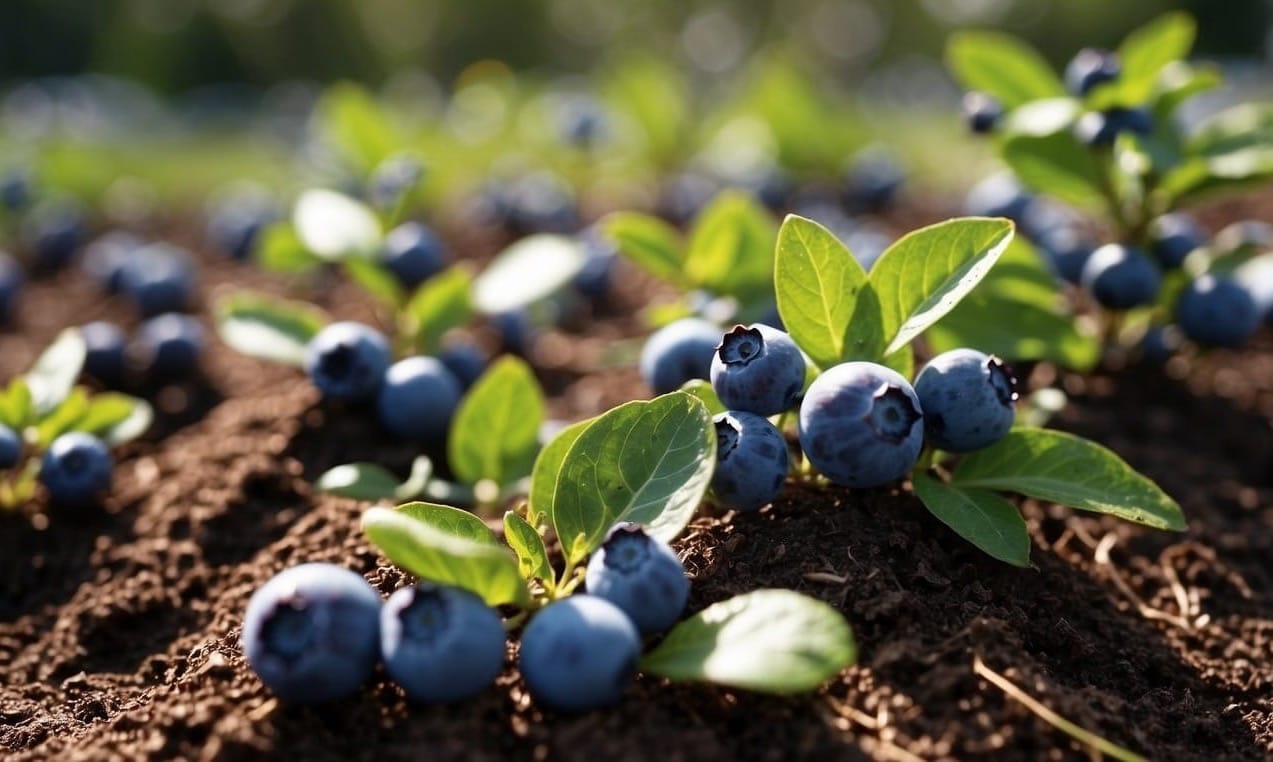
Equally important is the ongoing care, including proper watering, mulching, pruning, and protection from birds and pests, which ensures healthy bushes and bountiful harvests.
Key Takeaways
- Select climate-appropriate blueberry varieties and prepare an acidic, well-drained growing environment.
- Provide consistent care, including water, mulch, and pruning, for vigorous bushes and plentiful berries.
- Enhance pollination and protect from pests to maximize yield and enjoy a successful harvest.
Choosing the Right Varieties
The success of your blueberry crop hinges on selecting the appropriate varieties that align with your region's climate and your garden's specific conditions.
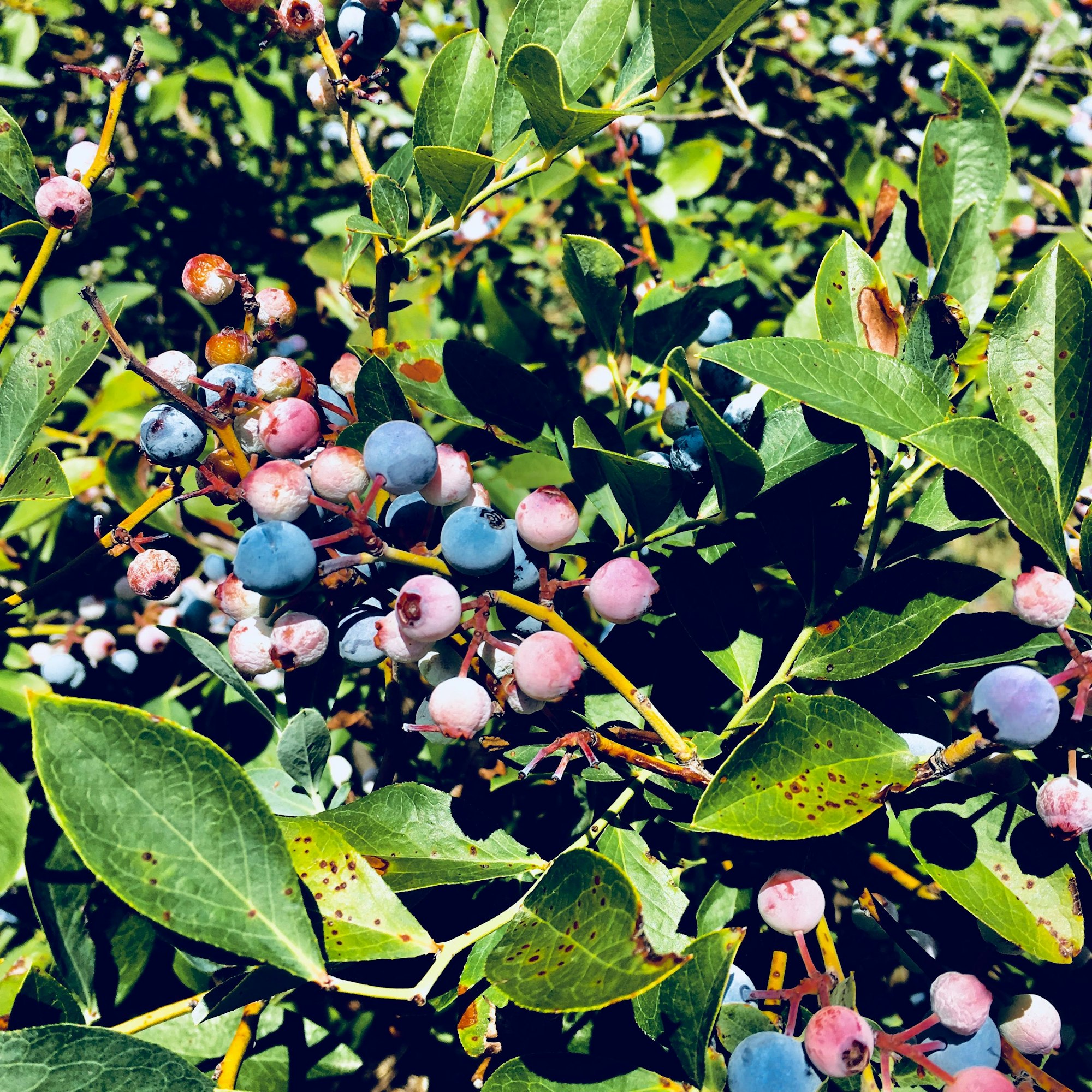
Understanding Blueberry Types
Blueberries are primarily divided into three types: highbush, lowbush, and rabbiteye. Highbush varieties are further split into northern highbush and southern highbush.
- Highbush blueberries are robust, suitable for home gardens, and include both the northern and southern subdivisions.
- Northern Highbush: These are taller plants, generally reaching 3 to 6 feet in height, and are adept at tolerating cold winters.
- Southern Highbush: Developed for warmer regions, these varieties can manage with less chilling time — the number of hours below 45°F (7°C) during the dormant period.
- Lowbush blueberries are known for their cold hardiness, staying under 2 feet tall and spreading through rhizomes. They often yield smaller, more intensely flavored berries.
- Rabbiteye blueberries are named for the pink blush that appears on the fruit as it matures. These plants are heat-tolerant and thrive in the southeastern United States.
- Half-high: A combination of highbush and lowbush attributes, half-high varieties are bred for cold climates, combining the hardiness of lowbush and the fruit quality of highbush blueberries.
Selecting Varieties for Your Climate
To ensure a successful harvest, match your blueberry variety to your climate:
- In northern climates, prioritize northern highbush or half-high varieties for their cold resilience.
- Southern gardeners will find greater success with southern highbush or rabbiteye varieties, which require fewer chill hours and can handle the heat.
- If you're in a coastal or more temperate region, consider the lowbush varieties, which are well-suited to these environments with their spreading habit and strong flavor profile.
Here's a brief guide to help you match blueberry varieties to your climate:
| Climate Type | Suggested Varieties |
|---|---|
| Northern | 'Jersey', 'Patriot', 'Bluecrop' (Northern Highbush), 'Northblue', 'Northcountry' (Half-High) |
| Southern | 'Legacy', 'Sunshine Blue' (Southern Highbush), 'Climax', 'Tifblue' (Rabbiteye) |
| Coastal/Temperate | 'Wild Lowbush', 'Top Hat' (Lowbush) |
Always look for certified disease-free plants and consider their maturity size when planning your garden space.
Certain blueberry varieties may also require a specific number of chill hours to fruit properly, so be sure to check these requirements against your local climate data.
Site Preparation and Soil Requirements
Growing healthy blueberry plants begins with careful attention to the soil.
Ensuring that you have the right pH, composition, and location will set the stage for a thriving blueberry harvest.
Testing Soil pH
Blueberries require acidic soil with a pH level between 4.0 and 5.0. To determine your soil's pH:
- Obtain a soil testing kit from your local garden center or send a sample to an extension service.
- Follow the instructions carefully to collect soil samples from several spots in the planned planting area.
- Mix the samples together for an average reading, as the pH can vary in different locations.
If the pH is higher than 5.0, you'll need to lower it, typically with sulfur or ammonium sulfate, to suit these acid-loving plants.
Adjusting Soil Composition
For optimal blueberry growth, your soil should have high levels of organic matter and provide good drainage. You can improve soil composition by:
- Incorporating compost, which can be made from decomposed fruits, vegetables, leaves, and other plant materials.
- Adding peat moss (specifically sphagnum peat) to increase acidity and improve soil structure. Aim for a mixture of one-third peat moss to your existing soil.
- Using sulfur to lower the pH if necessary, but remember to do it at least 6 months prior to planting to give it time to integrate and adjust soil chemistry.
Selecting the Ideal Location
The right location is crucial for blueberries. Look for a spot where your plants will receive full sun and have well-drained soil. Avoid heavy, clayey soils that retain water. Here's what to consider:
- Soil Type: Sandy soils or loams are preferable as they provide the necessary drainage blueberries need.
- Sun Exposure: A minimum of six hours of sunlight is needed, but more is better.
- Water Accessibility: Ensure the site is close enough to a water source for easy irrigation.
- Air Circulation: Good air movement helps prevent frost damage to early spring blooms and reduces disease risk.
Planting Blueberries

To ensure your blueberries thrive, specific timing, techniques, and conditions are key to a successful planting.
Your meticulous attention to these elements sets the foundation for your blueberry bushes.
Choosing the Best Time to Plant
If you are planting blueberries, the ideal time is during the cooler periods of early spring or late spring, after the threat of frost has passed but before the heat of summer sets in.
This allows your blueberry plants to establish a strong root system before facing the stress of summer heat.
Planting Techniques
- Preparing the Soil: Blueberries prefer acidic soil with a pH between 4.0 and 5.0. If necessary, amend the soil with sulfur to lower the pH. Incorporate aged compost or a blend of peat moss into the planting hole to enrich the soil and improve drainage.
- Planting Bare-Root Plants: For bare-root plants, dig a hole slightly wider than the spread-out root system, and deep enough so that the roots can extend without bending. Position the plant in the center, ensuring the crown is just below the surface, then refill the hole with soil and tamp down gently but firmly.
When to Fertilize: Avoid fertilizing at the time of planting. Introduce a balanced 10-10-10 fertilizer approximately one month after planting to give the plants a nutrient boost, distributing it around the plant, being careful not to touch the crown or stems.
Container Planting
- Choosing Containers: Select a container that is at least 12-18 inches in diameter with drainage holes.
- Potting Mix: Use a mix formulated for acid-loving plants or blend a mixture of 50% peat moss and 50% pine bark fines.
- Care: Ensure you water the containers consistently, as potted plants can dry out more quickly than those in the ground.
If you're dealing with poor or clay-heavy soil, plant your blueberries in containers or raised beds. Containers offer the advantage of customization of the soil environment and can be more easily managed and moved if necessary.
Caring for Blueberry Bushes
To ensure your blueberry bushes thrive, proper watering, mulching, and pruning are essential.
Adhering to these care guidelines will help maintain the health and productivity of your plants.

Watering
Blueberry bushes require consistent moisture to flourish. Specifically, they need about 1 to 2 inches of water per week.
During dry periods, you should water the bushes deeply once a week to ensure the soil is moistened thoroughly, but be careful not to overwater as this can lead to root rot.
- Week 1-3: Daily watering to establish roots.
- Week 4 and beyond: 1 to 2 inches of water weekly, or more if the weather is particularly dry.
Mulching
Mulch is vital for maintaining soil moisture, regulating temperature, and preventing weed growth.
Apply a 2 to 4-inch layer of organic mulch, such as pine bark or shredded leaves, around the base of your blueberry bushes.
Avoid piling the mulch directly against the stem to prevent rot.
- Organic Mulches: Pine bark, pine needles, shredded leaves
- Thickness: 2 to 4 inches
- Benefits: Retains moisture, suppresses weeds, adds organic matter
Pruning
Pruning is crucial for the health and productivity of your blueberry bushes.
Remove dead or diseased canes, and prune to encourage airflow and sunlight penetration. These are key for healthy growth and berry production.
- When to Prune: Late winter while the bushes are dormant.
- What to Prune: Dead branches, crossing branches, and any canes older than six years.
- Technique: Make clean cuts at the base of the unwanted branch.
Remember that consistent care is the foundation of a robust blueberry harvest.
Fertilization and Soil Nutrition

Blueberries thrive in acidic soil with proper nutrition. Your fertilization strategy is pivotal to the health and productivity of your blueberry bushes.
When to Fertilize
Early spring is the prime time to fertilize blueberry bushes.
Aim to apply fertilizer once the ground has thawed and roots are active, before the blooming period.
Additional lighter applications may be done after the initial spring feeding, typically in late spring and midsummer. But avoid fertilizing late in the season as this can lead to tender growth that's susceptible to winter damage.
Selecting the Right Fertilizer
Choose a fertilizer that maintains acidic soil conditions, with a pH between 4.5 and 5.5.
Ammonium sulfate is often recommended for its dual purpose. It provides nitrogen essential for plant growth and helps keep the soil pH low.
For organic options, a cottonseed meal or a specialized organic blueberry fertilizer blend can be suitable.
| Soil pH | Recommended Fertilizer |
|---|---|
| Above 5.5 | Elemental sulfur |
| 4.5 to 5.5 | Ammonium sulfate |
| Below 4.5 | Compost (neutral pH) |
Supplementing Nutrients
Beyond NPK (nitrogen, phosphorus, potassium), blueberries require a consistent supply of micro-nutrients such as magnesium and iron.
Compost and organic matter are excellent for improving soil structure and adding nutrients.
If your soil test indicates a deficiency, you may need to supplement with specific nutrients.
Elemental sulfur can be used to lower soil pH if it's not within the ideal range for blueberry cultivation.
Protecting and Maintaining Healthy Bushes
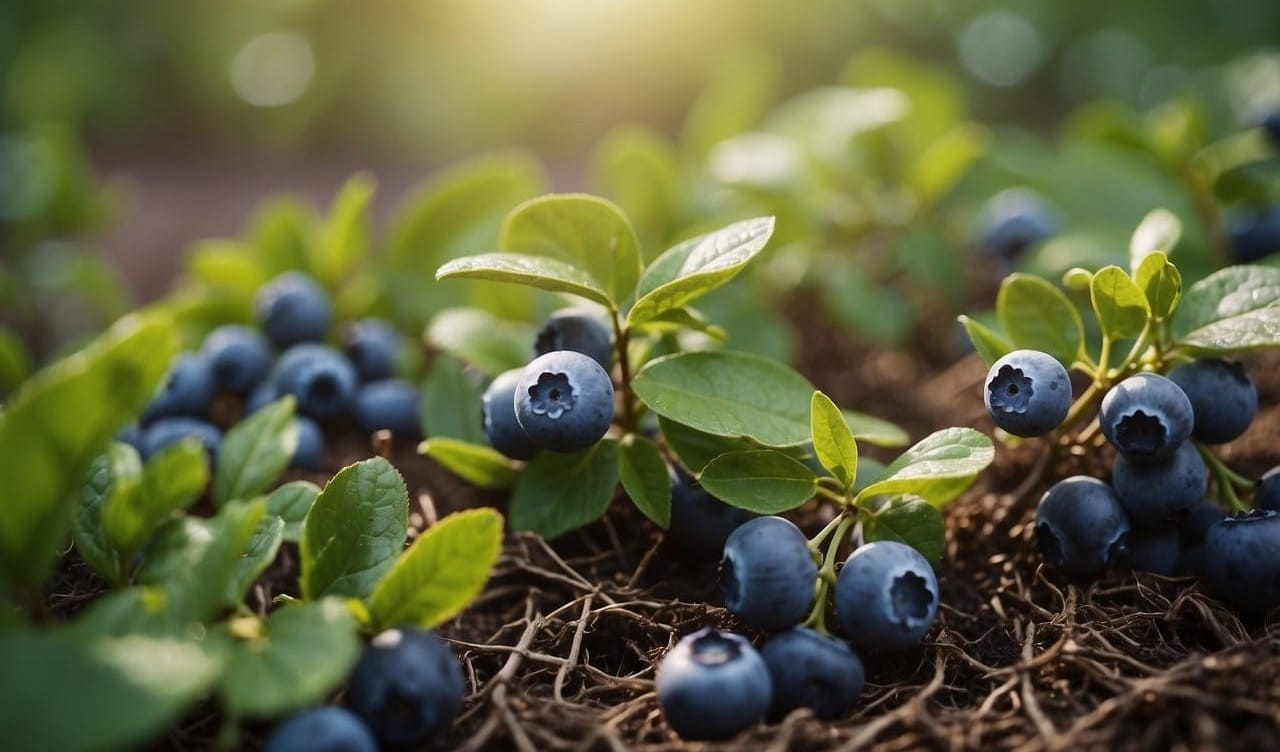
Growing blueberries requires vigilant protection and consistent maintenance to ensure the health of your bushes. This includes dealing with pests and birds and mitigating diseases that can hinder growth.
Dealing With Pests and Birds
Pests can be managed through a combination of cultural, mechanical, and chemical methods.
Regular inspection of your blueberry bushes for pests such as aphids, weevils, and mites is critical.
You can use insecticidal soaps or horticultural oils to control these pests. Just make sure to follow the product instructions for application rates and timing.
For birds that also pose a threat to your blueberries, bird netting is one of the most effective solutions.
Install the netting when berries begin to ripen and remove it after the harvest is complete to prevent birds from feasting on your berries.
- Bird Control:
- Install bird netting over bushes
- Remove netting post-harvest
Disease Prevention and Control
Disease management in blueberries involves proactive measures.
Ensure your planting site has good air circulation and sunlight penetration, as this can reduce the incidence of fungal diseases.
Apply recommended fungicides if necessary, but only as a preventative measure and not as a cure.
It's important to:
- Select Disease-Resistant Varieties: Choose cultivars known for their resistance to common diseases.
- Monitor for Symptoms: Watch for leaf spots, mold, and wilting that could signal disease presence.
- Pruning: Regularly prune bushes to remove diseased branches and open up the canopy to light and airflow.
Harvesting and Post-Harvest Care
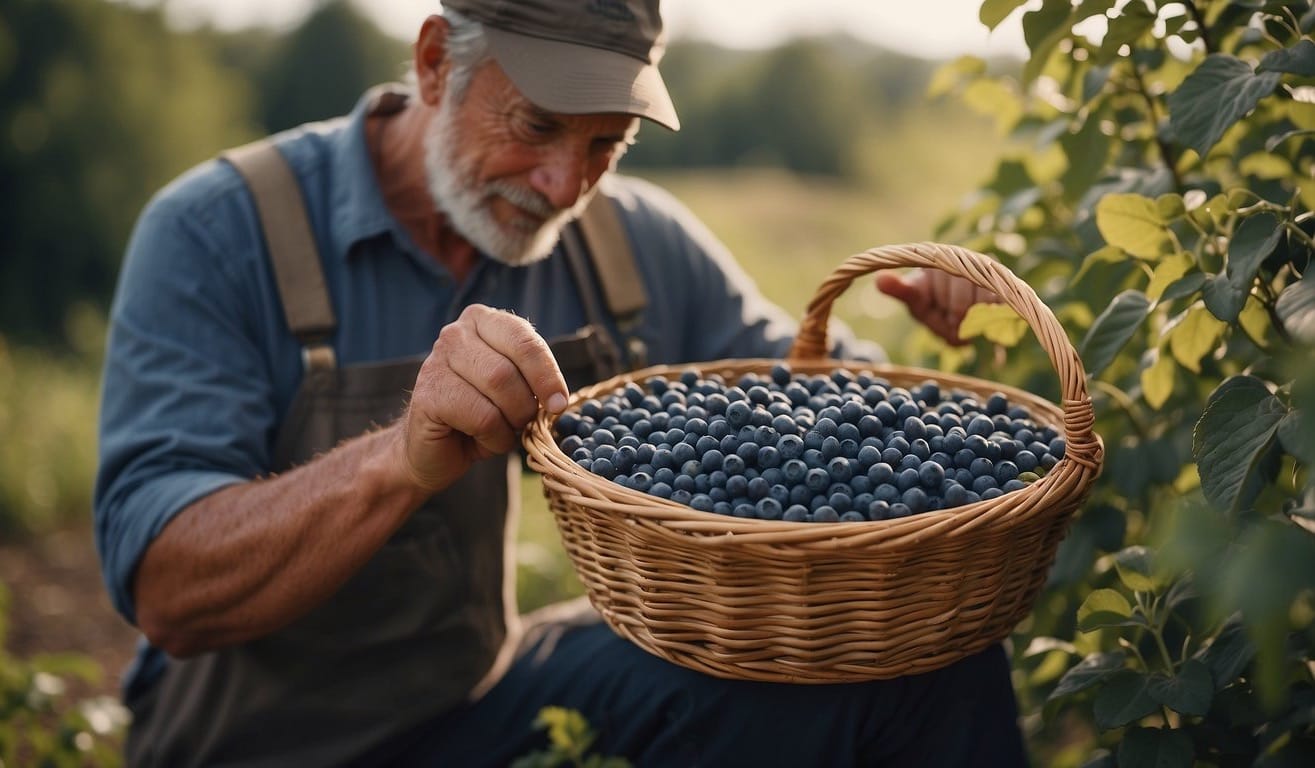
When you approach the end of the growing season, your attention will shift to the optimal ways to harvest and manage your blueberries to ensure maximum flavor and shelf life.
Recognizing Harvest Time
You'll know blueberries are ready for harvest when they reach a uniform blue color and detach from the bush with a light twist.
The fruit should be plump and firm with a slight give under gentle pressure.
It's essential to wait for full ripeness, as blueberries do not continue to ripen after picking.
Proper Harvesting Methodology
To harvest blueberries, gently roll the berries between your thumb and the palm of your hand, allowing the ripe berries to fall into your collection container.
Limit the handling of each berry to prevent bruising and potential spoilage.
- Do:
- Pick berries that are ripe and blue.
- Use a container to avoid dropping the fruit.
- Don't:
- Harvest under ripe, white, or green berries.
- Squeeze the berries too hard.
Storing and Preserving Blueberries
After harvesting, keep your blueberries cool, preferably in a refrigerator, to extend their freshness.
For long-term storage, blueberries can be frozen.
To freeze them, wash the berries gently, pat them dry, and spread them on a baking sheet to freeze individually. Then, transfer the frozen berries into airtight containers or freezer bags.
- Preserving:
- Fresh: Store in the fridge for up to a week.
- Frozen: Use for up to one year; excellent for smoothies, jams, or pies.
- Dried: Dehydrate berries for a snack or baking ingredient.
Enhancing Pollination for Better Yield
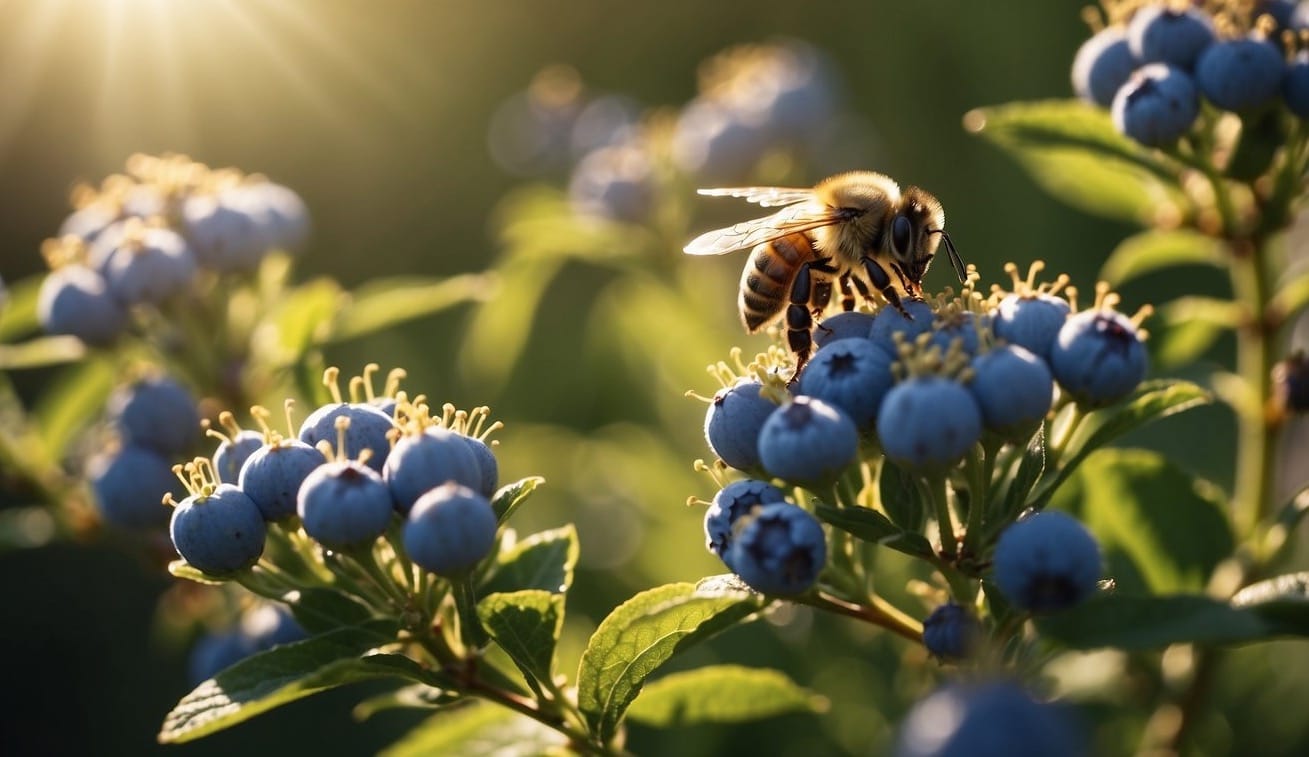
Maximizing your blueberry yield hinges on successful pollination. Understanding the process and attracting the right natural pollinators will ensure ample fruit set and high-quality berries.
Understanding Pollination Needs
Blueberries require pollination to produce fruit.
Each flower bud opens to reveal a small world where transfer of pollen is key.
Typically, blueberry plants benefit from cross-pollination, where pollen is shared between different plants, resulting in greater berry size and uniformity.
To achieve this, you need to ensure a diverse planting within your blueberry patch:
- Plant multiple varieties for cross-pollinate effectiveness.
- Maintain 1-2 honeybee hives per acre to ensure sufficient pollinator presence.
Attracting Natural Pollinators
Your blueberry plants rely heavily on bees and other pollinators to move pollen from flower to flower.
Enhancing your garden to attract these vital creatures is essential for optimal fruit set:
- Flower Diversity: Plant a variety of flowering species to provide food for pollinators throughout the season.
- Habitat: Create natural habitats like bee hotels and nesting sites to encourage pollinator populations.
- Pesticides: Avoid using harmful pesticides that can damage bee colonies; opt for natural alternatives when possible.
Additional Tips for Growing Blueberries

Beyond the basics of soil preparation and planting, enhancing your blueberry cultivation can lead to healthier plants and larger yields.
These additional strategies focus on optimizing the growing environment and promoting vigorous plant development.
Utilizing Cover Crops
Cover crops play a significant role in blueberry production by improving soil structure and fertility. They can also help in suppressing weeds and reducing erosion.
When selecting cover crops for blueberry bushes, you should consider the following:
- Rye or clover can be planted in the fall and serve as a winter cover, adding organic matter to the soil when tilled under in the spring.
- Buckwheat is a good summer cover crop option, which can be sown after you harvest the blueberries. It grows quickly and can be turned into the soil to add nutrients and improve soil quality.
Implementing Greenhouse Cultivation
Growing blueberries in a greenhouse can extend the growing season and provide protection against adverse weather.
When using a greenhouse, keep these considerations in mind:
- Ensure the greenhouse allows for full sun exposure. Blueberries require plenty of light, about 6-8 hours of direct sunlight per day.
- Regulate temperatures within the hardiness zones suitable for blueberry plants, typically zones 3-7.
- Use a greenhouse to protect plants from extreme temperatures, both hot and cold, which might otherwise stress the plants or reduce fruit production.
Frequently Asked Questions
Blueberries require specific conditions to flourish. From soil acidity to spacing, container gardening, essential care, and understanding your climate, these answers cover the fundamentals of blueberry cultivation.
What soil conditions are best suited for growing blueberry bushes?
Blueberry bushes need well-draining, acidic soil with a pH level between 4.5 and 5.5. The soil should also be rich in organic matter to ensure healthy plant growth.
What is the optimal spacing for planting blueberry bushes?
When planting blueberry bushes, space them about 4-5 feet apart in a row. Adjacent rows should be spaced 9-10 feet apart to provide ample room for harvesting and growth.
Can blueberry bushes thrive in container gardening, and how is it done?
Yes, blueberry bushes can grow in containers. Choose a container large enough for root expansion and use acidic potting mix. Ensure the container has good drainage and place it where the plant can receive full sun.
What are the essential care steps for maintaining healthy blueberry plants?
Regular watering, mulching, and proper fertilization are key. Apply a balanced 10-10-10 fertilizer one month after planting, and ensure consistent moisture without waterlogging. Pruning is necessary for removing dead branches and promoting new growth.
What is the expected time frame from planting blueberries to fruit production?
Blueberry plants typically begin to produce fruit within 2 to 3 years after planting. Full fruit production can take up to 6 to 8 years, depending on the variety and growing conditions.
How do climate and location affect the success of growing blueberries?
Blueberries thrive in regions with cold winters and warm summers. Climate affects dormancy and bloom times, which are crucial for fruit set.
Some varieties are more tolerant of different climates, so choose a type suitable for your area.


